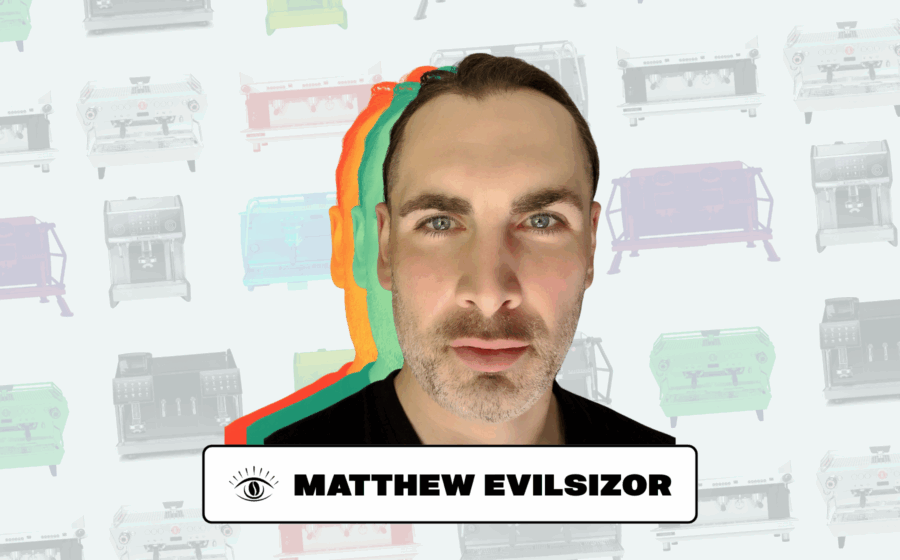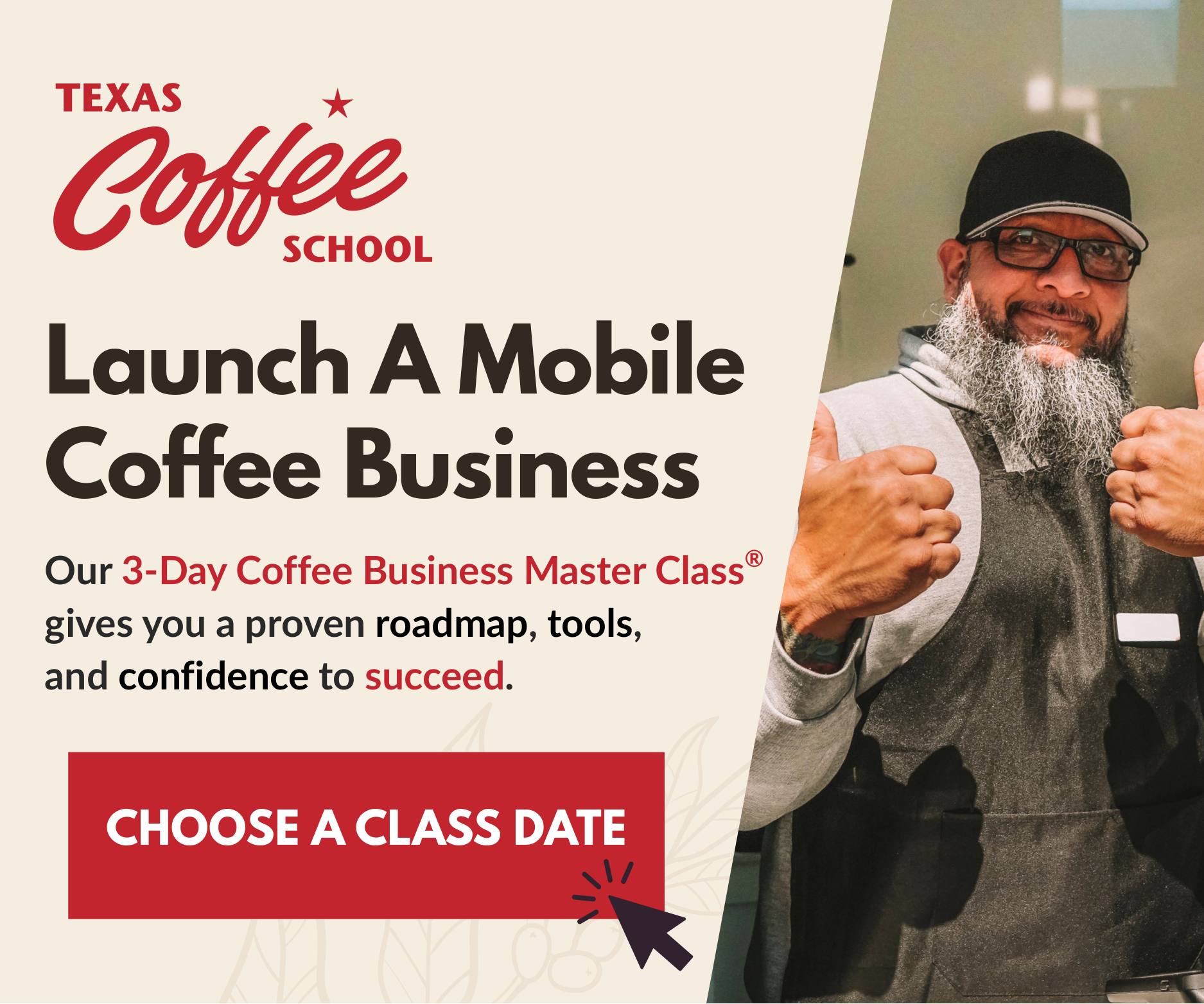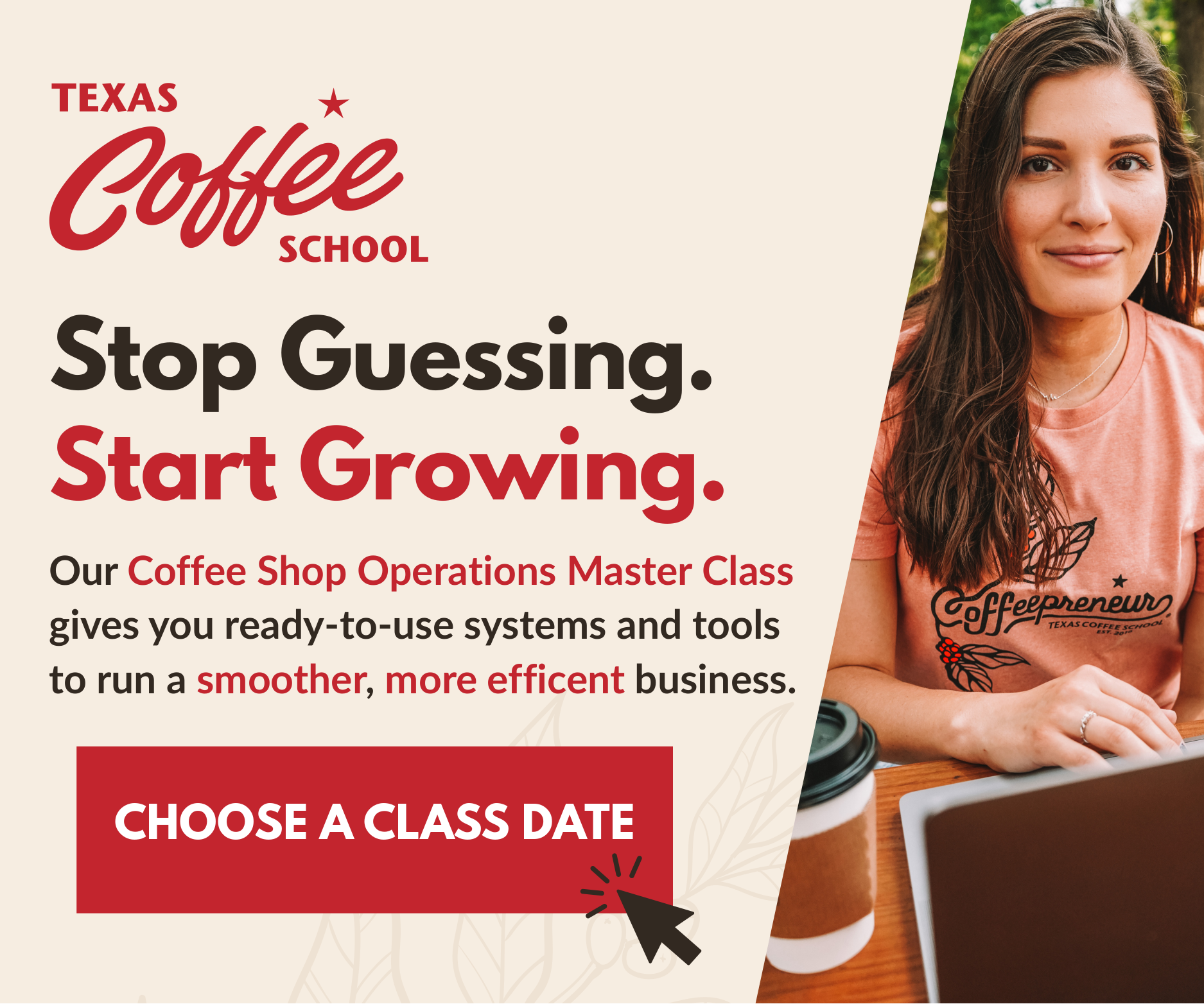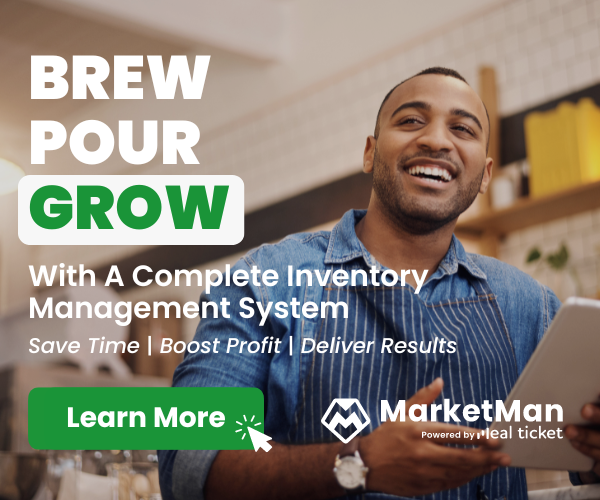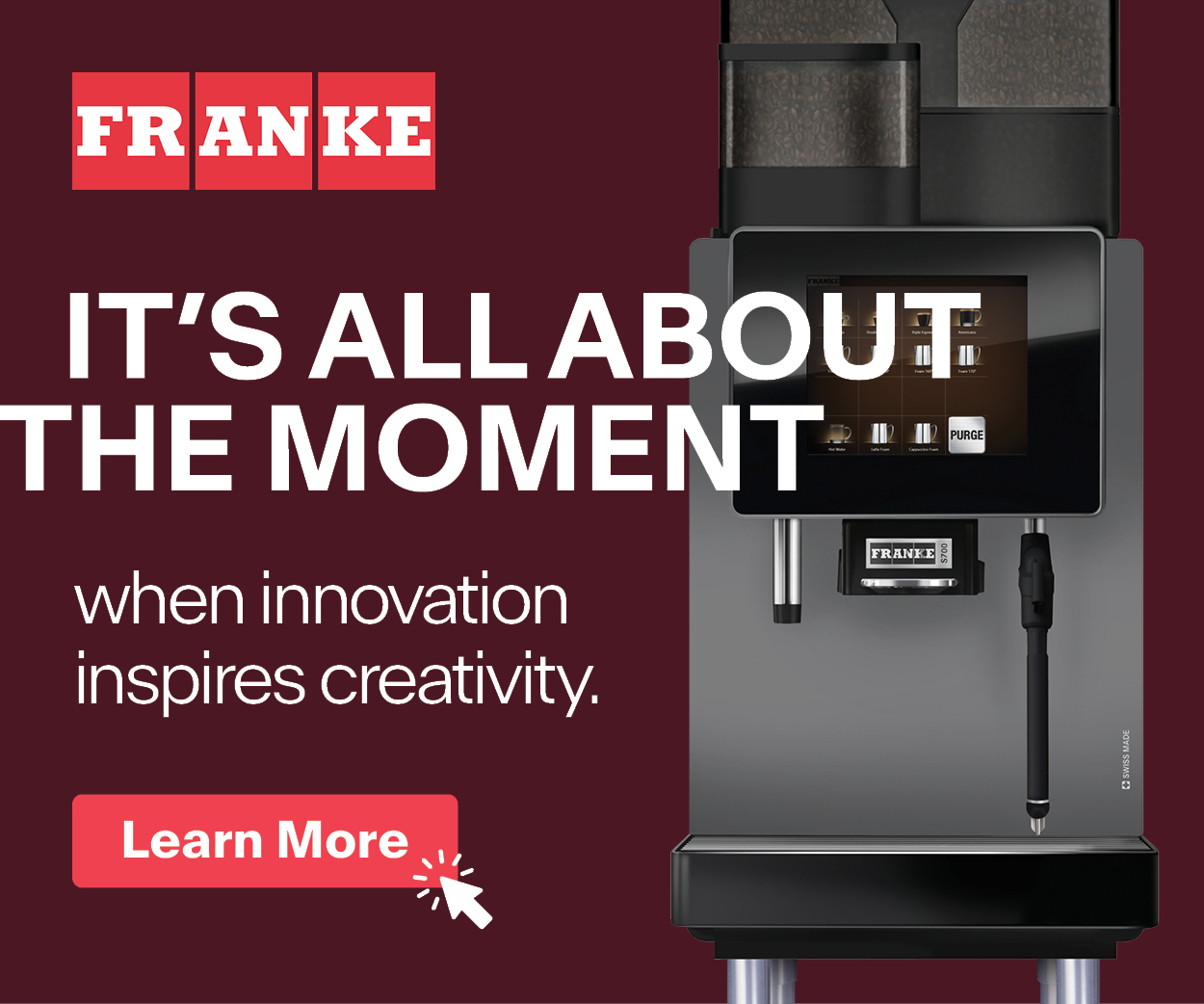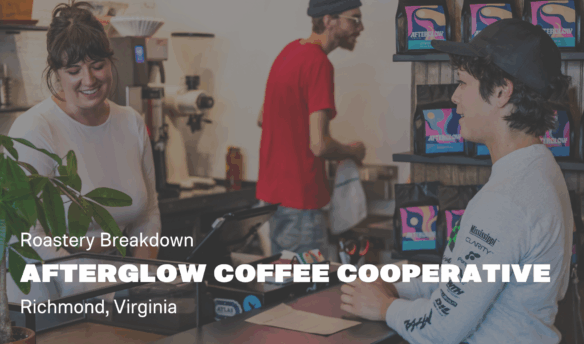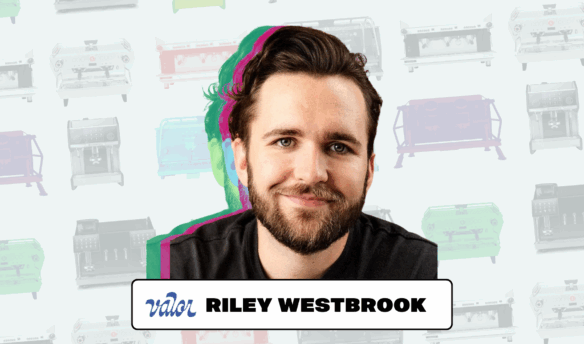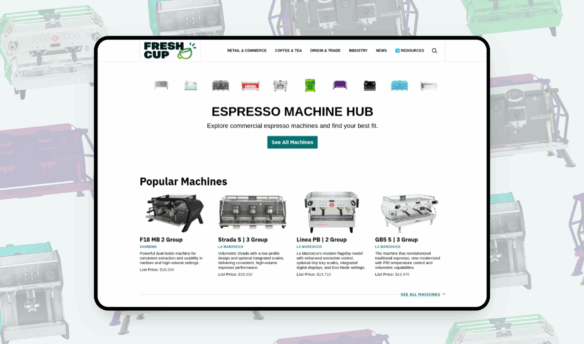Matthew Evilsizor refers to his company, Conscious Bean, as a “caffeination design firm.” The Los Angeles-based consultancy helps clients with everything from designing spaces and bar layouts to selecting equipment, developing menus, and sourcing custom coffee. In the 14 years since he started the company, Evilsizor has designed coffee experiences for companies from Rolls-Royce North America, The Academy Awards and Hulu to Aston Martin and NBCUniversal.
Evilsizor bases his espresso equipment recommendations on four key factors: staff skill level, desired product quality, maximum daily volume, and budget. His true expertise, however, lies in understanding how these elements work together to shape the best solution for each cafe.
Hey! We built a cool new tool to help you discover and learn about espresso machines called the Espresso Machine Hub! Check it out here!
In a conversation with Fresh Cup, he shares insights from his years of experience in the industry, and touches on everything from which espresso machine companies make the best equipment for specific environments to managing power for mobile setups. He also goes into why most restaurants shouldn’t serve espresso (and what they should do instead); the workflow principles that should drive your bar design; and why he believes telemetry, or the ability to track and transmit data, might be the most underrated feature in modern espresso machines.
If you’re looking for your next (or first) commercial espresso machine, this interview is a must-read:
One of the most important principles you emphasize when you work with new clients is workflow. Why?
Workflow is everything. In terms of flow, one key principle is that people work in triangles—so it’s essential to have everything within a 45-degree radius of your main position. This varies by shop since your primary offerings will shift based on your core customer, and your layout should adapt accordingly.
Bar flow ultimately comes down to the frequency of use (including dairy or non-dairy placement, cup/lid location, etc.) and the effort required to complete each task (i.e., opening the fridge, bending over to get the milk, pulling out the container, standing up, removing the cap, pouring the milk, replacing the cap, opening the door, bending over and returning the milk to the fridge, and closing the door.)
Those are just the steps to pour dairy for a drink. Seeing these highly repetitious micro-actions spotlights where our time [is spent], and where repetitive stress injuries occur. Dialing this in improves output pace, minimizes waste, and reduces injuries.
The key is to be deeply intentional about who you are serving (your target customer) and what they desire (their preferred drinks and offerings). This determines the flow of your bar. Designing your setup around your primary drink selections allows you to heat-map the micro-actions of your process; this will naturally organize your space efficiently. Seeing this flow in action can also inform customer movement through your space—and vice versa.
Which espresso machine(s) would you recommend for a coffee cart or truck?
The number-one factor to consider is how much power you can access. For a coffee cart, most locations run on 110V. It can be difficult or impossible to access 220V, which means a single-group machine is typically the best option.
If you need to put out over 120 drinks an hour, you’re nearing the perimeter of mathematically possible flow rate/output from a single-group machine. So if one single-group is not enough? Either bring a huge (and loud) generator to power a double-group, or I’d recommend two single-group machines run to individual 110V circuits instead of a double-group for events. Otherwise, you’ll constantly run into power issues.
Another key consideration: Do you have to lift the machine onto the cart? If so, think about what you can physically handle. A full-size espresso machine can be heavy, and if you’re setting up solo, that weight can become a major issue.
Beyond power and portability, boiler size is crucial. I know I just said to be aware of size/weight constraints, but most events require high output, so you need at least a single-group machine to produce more than 60 drinks per hour efficiently.
For a coffee truck, the same concept applies—how much power can you get? If your truck can support 30-50 amp 220V, then you can run a double-group machine. But you may need a larger truck to facilitate that much power draw.
Which espresso machine(s) would you recommend for a high-volume coffee shop or cafe?
I know my answers tend to be philosophy-based rather than just product recommendations, but there’s a lot of great equipment out there—it’s about understanding the intent behind choosing one over another.
Here’s the question: What type of cafe do you want?
- High-end “third-wave” café: If you’re aiming for a specialty, high-quality experience, go with a classic double-group machine like La Marzocco, Slayer, or Victoria Arduino. However, be prepared to invest in a strong training program to ensure consistency. Skilled baristas are essential for maintaining quality.
- High-volume, fast-service model: A super-automatic machine is the way to go, with the size based on your daily customer maximum. This significantly reduces the training burden—you’ll still need staff training, but the required skill level is much lower.
- Somewhere in between, but on a budget: A classic double-group machine with automatic steam wand upgrades (like those found on mid-level Nuova Simonelli machines) can be a great option. However, if you want consistency, you’ll still need to build a solid training program.
- Hybrid model, balancing automation and skill: If you want to offset some skilled labor but still have the flexibility to go classic when a skilled barista is available, a high-end super-automatic like the Eversys is a strong choice. These machines allow for manual, semi-manual, and full-auto operation, letting your cafe adapt to the skill level of your staff. You still need a training program, but you can shift more focus to customer experience and staff development rather than just technical skills.
Would you recommend restaurants invest in an espresso machine?
Nothing ruins a great meal faster than a mediocre espresso. It’s a glaring issue in most restaurants. I can count on one hand how many good espressos I’ve had at the end of a meal.
I know that the low traffic of the coffee bar makes it a second thought, but that might be the hint of how you should position your business. If you have an espresso bar in your restaurant, it needs a proper training program and protocol process. Your staff must know how to prepare a good espresso-based drink. If they can’t make cafe-quality espresso consistently—don’t offer it!
(So here are the two options:)
Go all-in on espresso.
If you’re starting an espresso program, you’re now also a coffee shop. Do invest in a good-quality grinder and a good-quality espresso machine. For 90% of restaurants, a single-group espresso machine will have more than enough output capacity (and save you lots of money on power).
Or, skip espresso.
Skip espresso altogether and focus on a pour-over, drip, or French press coffee program. The equipment will cost less, and the training will be simpler. If you don’t have volume and you don’t want to put the effort into being a restaurant and cafe, then don’t get an espresso machine in your business. A French press program or pour-over can make a great end-of-meal experience and be far more replicable.
What about drive-thrus or other speed-focused settings?
For a drive-thru, it’s all about consistency and speed. Super-automatic machines are the only way to go. I’m a fan of Eversys, but Franke also does a great job. For a drive-thru, every second counts. A high-quality super-automatic ensures a fast, repeatable process without sacrificing drink quality.
What do you tell folks who are looking for an espresso machine on a budget?
For a professional cafe (even on a small budget), the core considerations remain the same: skill, consistency, and output pace.
If you’re on a tight budget, your biggest investment should be in training. You can take some shortcuts on equipment costs, but shortcuts in training always come back to bite you. I recommend considering used equipment, but always have a certified espresso tech inspect it. Just like you’d have a mechanic you trust check a used car before buying it.
If you’re going with more affordable equipment, don’t cut corners on the grinder. Additionally, maintaining your equipment religiously will be the best cost-saving measure you can do.
What’s one thing coffee business leaders should think about when buying a commercial espresso machine?
I think there are four key factors every new cafe owner should consider:
- Skill level of staff: Your staff’s skill level directly impacts consistency, quality, and customer experience.
- Product output quality: It’s not just about what machine you buy—it’s about how well your team can use it. You may not have the budget for the most expensive espresso machine, but beware that a poorly trained team using classic equipment will lead to inconsistent drinks and lost customers.
- Daily output volume maximum: How many customers will you serve per day? How many in peak hours? What about as your company grows? You want to pick a machine that can perform at those peak times.
- Budget: Every cafe must balance skill, quality, volume, and budget—understanding this from the start will set you up for success.
If you have a smaller budget, invest in two things: 1. Training to maximize lower-cost equipment, and 2., Good-quality commercial grinders.
What’s the most underrated feature of an espresso machine you’ve come across?
Telemetry. If you don’t know your given circumstance, how can you establish a baseline, dial in, and standardize? Consistency is everything.
Any final suggestions?
A grinder is just as important as the espresso machine. A great machine with a bad grinder will still produce an inconsistent product. Invest in high-consistency grinders that match your output needs.
[You should also] be intentional about the type of business you’re building. Define who your customers are, what they want, and how many you’ll serve daily—these factors will shape your equipment choices.
It’s about the right tool for the right job. Your setup should be designed around your workflow, output needs, and staff skill level. The best espresso machine is the one that fits these three aspects of your cafe’s demands.
This interview has been edited for length and clarity.



